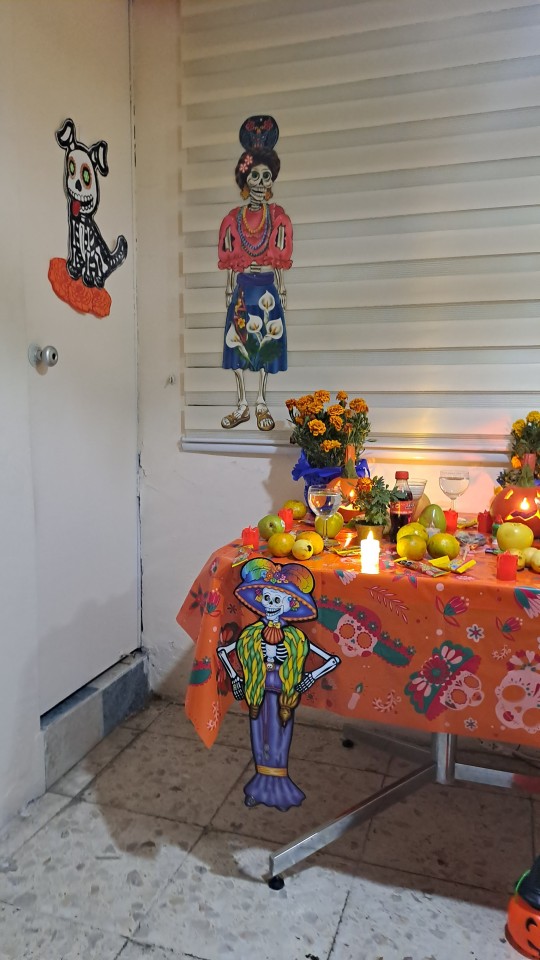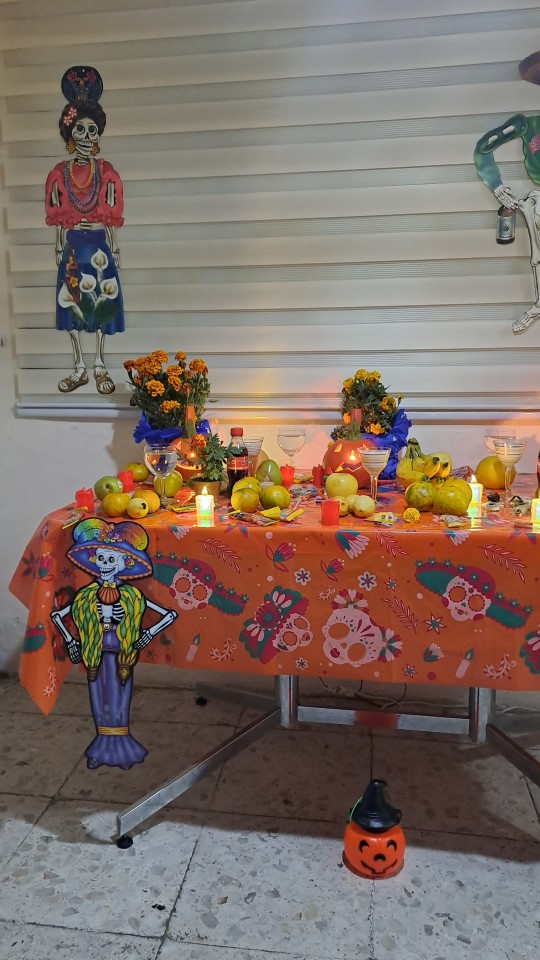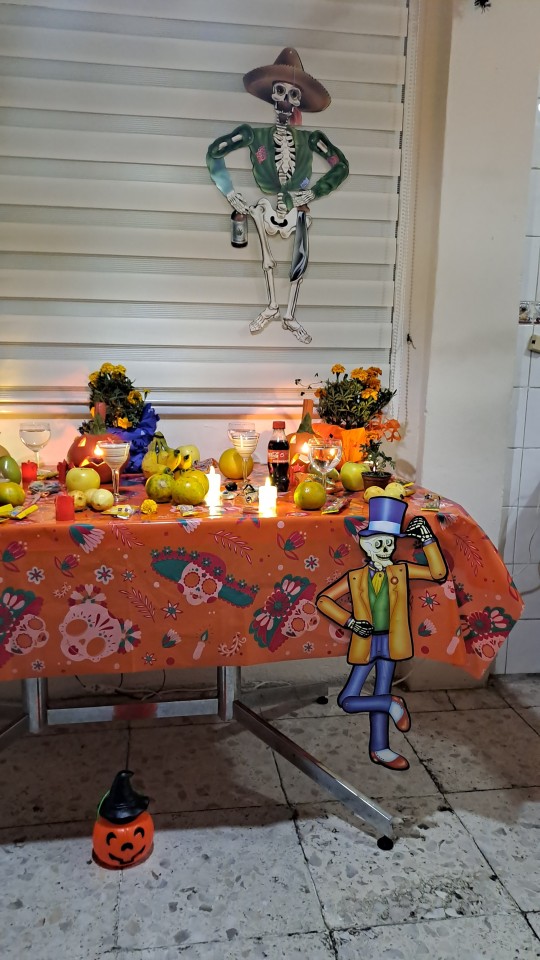Dia De Muertos - Tumblr Posts - Page 2

IT👏IS👏NOT👏A👏COSTUME👏
It's original name is Calavera Garbancera (Chickpea Skull) and was created in Benito Juárez, Sebastián Lerdo de Tejada and Porfirio Díaz governments to express the discontent of the people and was a symbol of social and political denunciation that eventually became a traditional wear for day of the dead. This wear is called La Catrina, its not a representation of dead itself but that of a dead woman, and it was created by cartoonist José Guadalupe Posada.
(this 👇 is the original calavera garbancera engraved in metal)

Back then texts called calaveras alegres (cheerful skulls) were written by middle class people critiquing in a mocking way the upper class and the country's situation and were published in "combat newspapers" - this texts were accompanied by drawings of skulls and skeletons dressed in gala clothes, drinking pulque, riding on horseback and in high society parties but all of this in lackluster neighborhoods to represent the misery, the political mistakes and society's hypocrisy.
Origin of the name cheakpea skull: cheakpea merchants were notorious for being indigenous people that tried to pass as European and denied they're indigenous origins and their culture. They would dress in high class clothes but live very precariously. Posada tried to convey that in this work of art that was a critique to the Mexicans that were poor but tried to sustain an European lifestyle that they couldn't afford.
Originally she was naked except for a very big and elegant hat with ostrich feathers. Diego Rivera dressed her up and gave her the name La Catrina when he painted this mural 👇

(Catrin was the name given to extremely elegant and wealthy Mexican aristocracy in XIX)
Posada said this about his inspiration: "Death is democratic. Blonde, brunette; rich, poor; everyone ends up being skulls" and this quote is basically the reason she became so traditional on the day of the dead, since it represents so well mexicans point of view about it.
And the texts that accompanied her (the cheerful skulls) became the calaveritas literarias (literary skulls) which are traditionally Mexican verse compositions that are written on the eve of the day of the dead as a manifestation of culture to make fun of both the living and the dead, and remember that we are all going to die. They are written in a satirical or burlesque language and are very short texts that reflect all the spirit and festivity in the face of death.
This

Is

Not

A

Costume

It

Is

Mexican

Culture

THATS A MEXICSN ARTIST FOR YOU

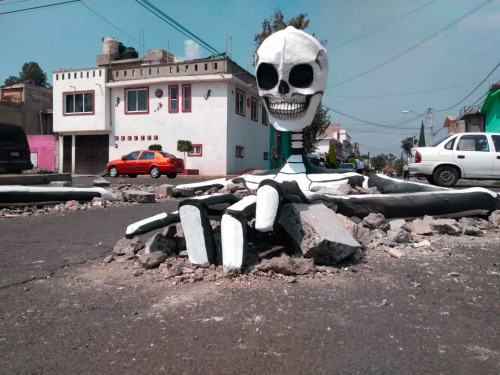
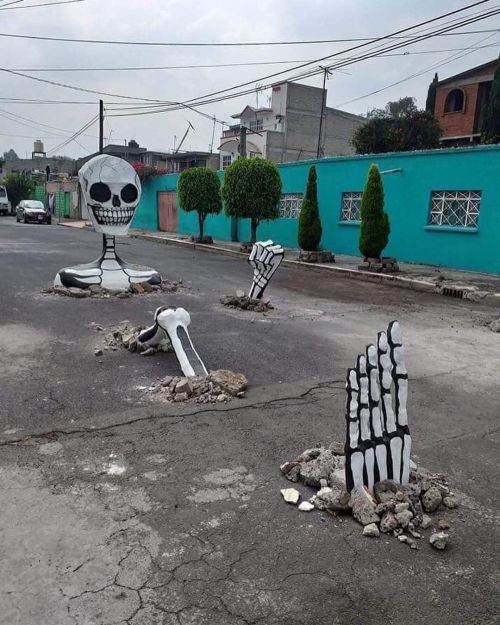

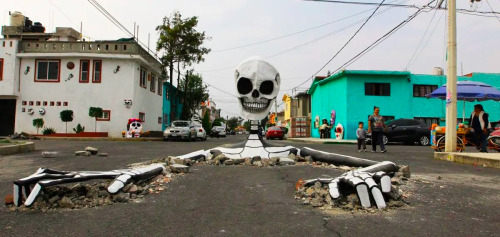
Día de Muertos Skeleton Mexico-based artist Raymundo Medina built a massive skeleton that appears to be lurching out of the pavement on a street in Santa Cecilia Tláhuac, Mexico. Piles of crumbled concrete at the places where the skeleton is connected to the street create the illusion that it is bursting through the asphalt.
Some of my favorite day of the dead inspired drags by la mas draga contestants.
red rabbit duo

sophia jimenez

jobstar
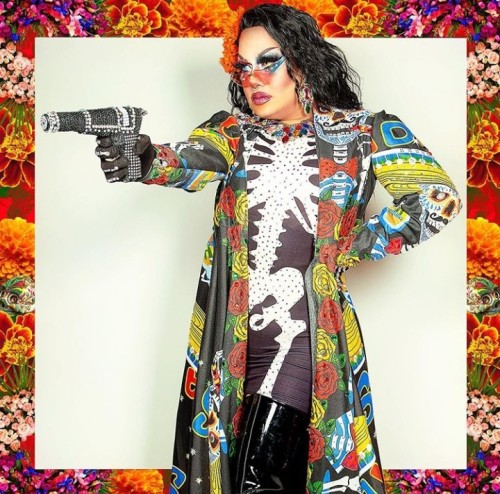

debra men

deborah la grande


BONUS: letal (a judge)




A traditional cultural garment expresses an identity through clothing, which is usually associated with a geographic area or a period of time in history. It can also indicate social, marital or religious status. The clothing is used to represent the culture or identity of a specific ethnic group, it is also known as ethnic dress, ethnic wear, ethnic clothing, traditional ethnic wear or traditional ethnic garment. Such clothing often come in two forms: one for everyday occasions, the other for traditional festivals and/or formal wear.
The catrina is a traditional cultural garment. Its culture. It's not a costume. Its traditional clothing wore in a traditional festival/holiday that's associated with a period of time and a political and social denunciation of hypocrisy.
Its not worn everyday because it's a festival traditional garment and thats the whole fucking point.
This

Is

Not

A

Costume

It

Is

Mexican

Culture

DAY OF THE DEATH OFFERINGS (ALTARS) IN MEXICO

The offering (altar) for the dead should have several essential elements, and each of them has their mysticism:
Water. The source of life is offered to the souls to quench their thirst after their long journey and to strengthen their return. In some cultures symbolizes the purity of the soul.
Salt. The element of purification, serves so that the body is not corrupted in its round trip for the following year.
Candles. Ancient Mexicans used ocote slices. Today the candle is used; the flame it produces means faith and hope. It is a guide for the souls so they can reach their old places and return to their home. In several indigenous communities, each candle represents a deceased, that is, the number of candles that the altar will have will depend on the souls that the family wants to receive. If the tapers or candlesticks are purple, it is a sign of mourning; and if four of these are placed on a cross, they represent the four cardinal points, so that the soul can orient itself until it finds its way and its home.
Copal and incense. The copal was offered by the natives to their gods since the incense was not yet known, it arrived with the Spanish. It is the element that sublimates prayer or praise. Fragrance of reverence. It is used to cleanse the place of evil spirits so that the soul can enter your home without any danger.
Flowers. They adorn and aromatize the place during the soul's stay, which will leave happy when it leaves, the wallflower and the nube cannot be absent because they mean purity and tenderness, and they accompany the souls of the children.
In many parts of the country it is customary to put petal paths that serve to guide the deceased from the holy field to the offering and vice versa. The leafless yellow flower of the cempasuchil (Zempoalxóchitl) is the path of color and smell that trace the routes to the souls.

Petate. Among the many uses of the petate are that of a bed, table or shroud. On this particular day it works for the souls to rest as well as a tablecloth to place the food of the offering.
Izcuintle. This one should not be missing in the altars for children, it serves as a toy so the souls of the little ones feel happy when they arrive at the banquet. The izcuintle dog is the one that helps souls cross the mighty Chiconauhuapan river, which is the last step to reach Mictlán.

Bread. Made in different ways, bread is one of the most precious items on the altar. The most common one is the “bread of the death”, a bread sprinkled with sugar that symbolizes the bones of the living.

Gollete y cañas. Related to the tzompantli. The golletes are loaves in the shape of a wheel and are placed in the offerings supported by pieces of cane. Depending on your upbringing, they may symbolize the skulls of the defeated enemies and the cañas the rods where they were threaded OR the roundness of the gollete may symbolize the circle of life and the cañas the life passing through towards dead.

Other objects to commemorate and offer to the faithful departed are:
The portrait of the person remembered, in more traditional offerings it must remain hidden, so that it can only be seen with a mirror, to imply that the loved one can be seen but no longer exists.
The image of the Souls of Purgatory, to obtain the freedom of the soul of the deceased, just in case it is found in that place, to help it get out.
Other images of saints can be placed, to serve as a means of interaction between the dead and the living, since on the altar they are synonymous with good social relations. In addition, they symbolize peace at home and the firm acceptance of sharing food, such as apples, which represents blood, and kindness through the pumpkin in tacha candy.
The mole with chicken, hen or turkey, is the favorite dish that many indigenous people from all over the country put on the altar, although they also add barbecue and consommé. These dishes are that trail of aromas, the kitchen banquet in honor of remembered beings. Good food is intended to delight the soul that visits us. It is most traditional to place foods that were the favorites of the deceased that are awaited for the night. If adult souls are expected, you may find wine on the altar.

Chocolate water. Pre-Hispanic tradition says that the guests drank chocolate prepared with the water that the deceased used to bathe, so that the visitors were impregnated with the essence of the deceased.
Another very common element are sugar skulls. Medium sugar skulls are allusion to the ever-present death. The small skulls are dedicated to the Holy Trinity and the big one to the Eternal Father.

A washbasin, soap and towel can also be placed in case the soul needs to wash its hands after the long journey.
This post follows what the INPI (National Institute of Indigenous People) says about the Mexican Day of the Dead on its official page.


Feliz 1 de noviembre también conocido como el día de los muertos!
No soy de Mexico así que hize lo mejor que pude con ellos y sus estilos aunque Talvez pude aver hecho también algo referente a mi país...
creditos a Antonio Coronado por todos sus personajes
Estaba planiado un personaje más pero lamentablemente no me pertenece y sucedió unas cosas hace unas semanas así que en resumen diré que algunos personajes que estaban planiados o llegue a nombrar unas veces ya no estarán por respeto y derecho a su creador


Forgot to post this sooner, ¡Feliz día de los Muertos!

Feliz Día de Muertos from Hueso’s Pizzeria 💀✨
Alsooo, didja know soft shells and red eared turtles are originary from Mexico? Diversity wins, we got afro-latino-japanese turts 🙏

Feliz Día de Muertos from the cutest fencer, Bobby Rogríguez!💀💕
These are so fucking cool!! 😍😍 catrínas are just cool, period 😁
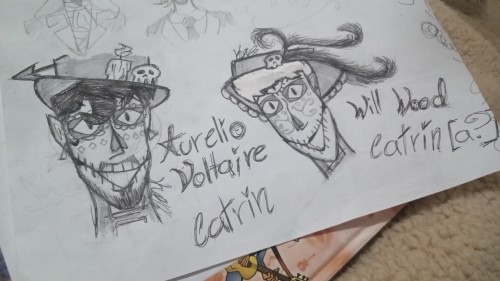
Los Catríneeees

we'll carry on🕊️🖤⚰️


Happy day of the dead everybody!!! I drew shamura with catrina makeup! Day of the dead is actually my favorite celebration! (and im fluent in spanish)
Feliz Día De Los Muertos
✨💀🕯️🏵️✨

Muy buenas a todos, hoy estoy muy emocionado porque hoy es el Día De Muertos una celebración muy importante para los mexicanos y solo se celebra cada año y además son uno de mis festividades favoritas ( ꈍᴗꈍ)✨
Y para celebrar este gran día, les comparto este magnífico dibujo de mi oso Cody (y además ese es el mismo dibujo de hace un año que hice y pensé rehacerlo de nuevo) deben admitir que me quedo fabuloso jeje (。•̀ᴗ-)✨
Bueno espero que les gusten a todos y que tenga un maravilloso día (◍•ᴗ•◍)👍💖
Cody Bear Module: Catrín
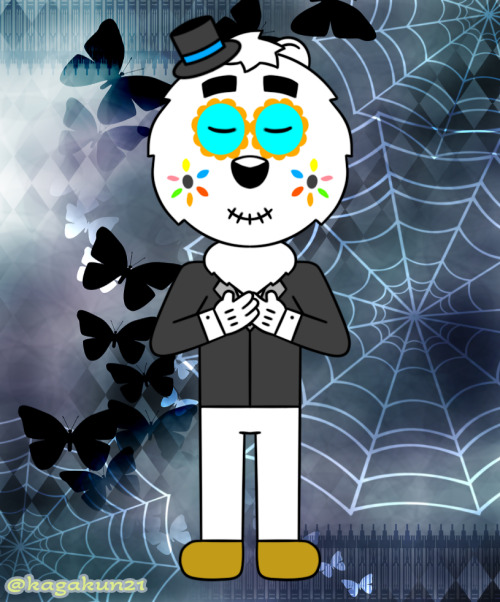
Versión
Wolf & Otter: En 3... 2... 1... ¡FELIZ HALLO....
Otter: ESPERA WOLF!!!!!!!
*Otter interrumpen*
Wolf: ¿Que paso otter?
*Wolf le pregunta a Otter*
Otter: Ya notaste que Halloween ya terminó hace como dos días...
Wolf: Oh es verdad... Y entonces que se celebra el 2 de noviembre...?
*Otter pensando que se celebra esté día*
Otter: Aah ya sé
*Otter le susurra al oído a Wolf*
Wolf: Oh, cierto... No sé porque se me olvidó este día tan importante
*Otter y Wolf se preparan*
Wolf & Otter: Ok en 3... 2... 1... ¡FELIZ DÍA DE MUERTOS! ✨🐺💛🦦💀🏵️🕯️✨

Muy buenas a todos y feliz día de muertos, hoy les quiero compartir este magnífico dibujo especial para celebrar el 2 de noviembre y esta vez está el dúo favorito de todos; hablo de mis dos Fursonas Sweet Wolf y Mr. Pumpkin Otter ✨🐺🎃🦦✨
Okay siendo sincero este dibujo se tenía planeado para el 31 de octubre pero hubo un cambio de planes que digamos... Pero bueno sé que ellos se perdieron del Halloween, pero no hay excusas para que se puede celebrar el día de muertos saben...(? En fin.
Este dibujo fue hecho por el artista Lucas Constanza gracias otra vez por hacerme este magnífico dibujo enserio valoro mucho de tu trabajo (。・ω・。)ノ💖
Bueno sin más preámbulo, espero que les gusten a todos y que pasen un excelente día.
Damas, no-binarios, y caballeros: Me complace comunicarles hoy 3 de agosto del año 0 después de Twitter que ya estamos en Temporada de Pan de Muerto. Y no lo digo yo, lo dice Soriana:

Hoy mismo me encontré con este letrero en una tienda Soriana de mi ciudad, en donde ya manejan lo que viene siendo el Pan de Muerto miniatura en pieza individual o en six-pack:

No vi por ningún lado el Pan de Muerto grandote (lo cual es desafortunadamente común en los supermercados), pero al menos si me tocó ver Pan de Muerto con rellenos cremositos varios y hasta una versión con Oreo que no me había tocado ver antes:

Consideren esto como su banderazo de salida para empezar a comprar Pan de Muerto, comer Pan de Muerto, y hasta preparar Pan de Muerto. Digo, para que dejamos que Soriana se quede con toda la diversión (y beneficio económico) de la Temporada de Pan de Muerto, si Profeco dice que el Pan de Muerto casero cuesta casi la mitad que la versión de supermercado.

